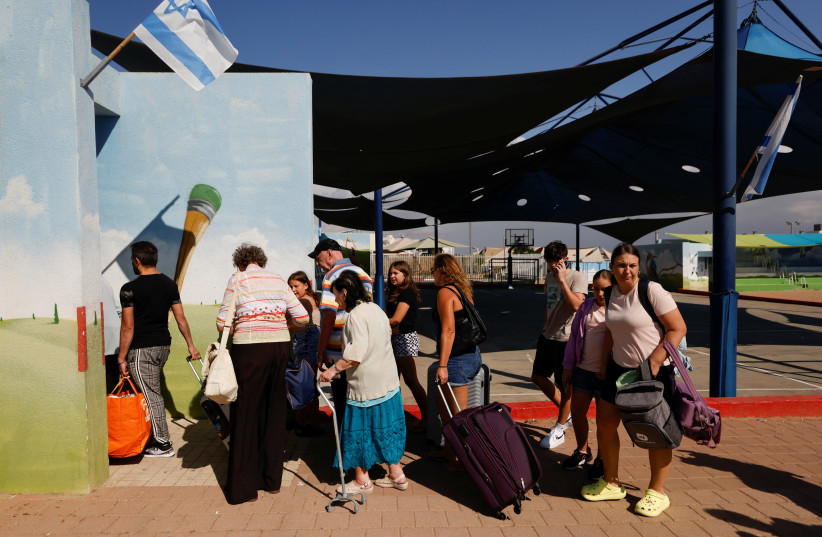
The Hamas attack on Israel on October 7 and the subsequent decision by Hezbollah terrorists to begin firing rockets and other munitions at Israel have created an unprecedented challenge.
To date, Israel has evacuated more than 125,000 people from more than 100 border communities. This is only the tip of the iceberg of the challenge because many more tens of thousands of people have been affected.
How will the people return?
Returning civilian life to Israel's border zones
In late December, I got to see how some of the changes along the border with Gaza could enable people to slowly go back home. For instance, fighting in the northern Gaza Strip has been reduced in recent weeks. That means the plumes of smoke and constant sound of artillery and airstrikes are reduced. Hamas rocket fire has also been reduced.
The roads that link Israeli communities on the southern border are also reopening. That means one can now easily drive from Sderot to Ashkelon, passing near Erez and Yad Mordechai. This road had been attacked on October 7; now it has new signs, and civilians are returning to use it.

In other areas along the Gaza border, there is more peace and tranquility than in the past. When the war began, this area was overrun, and communities suffered massacres. But today, one can drive near Re’im and see new armored shelters near the bus stops. They are white and not yet painted like most of the older ones. Tragically, some of the older ones near Re’im became death traps on October 7 when Hamas tossed grenades into them to kill those sheltering inside.
Other aspects of life are returning as well. People are now riding their bikes near the Gaza border. These are people who are out for exercise, but the symbol of riding a bike a few miles from a war zone illustrates that peace can prevail.
But there is still much to do. The Israeli government has set aside funds to renew these communities. Some of them require reconstruction; others need new fences, safe rooms, and defenses.
The evacuees from the North and the South have been living in hotels since October. In some cases, communities were able to move to certain hotels as a group, keeping their community partly intact; in other cases, this did not happen. It is more difficult for a city like Sderot to revive the sense of community.
Also, many people in these communities were called up for war, meaning that the hardship of relocation has been compounded by having families where one parent has been at war for almost three months.
The difficulty of returning civilian life to the border areas is immense. For instance, in the North, Hezbollah continues to fire rockets and missiles every day. There are also drone threats. Israel’s leaders and security officials have all vowed that the situations in the North and the South will not return to how it was on October 6. They want security to be paramount now. That means Hezbollah must be removed from the northern border.
This creates a complex challenge. So long as Israel’s leaders vow that Hezbollah must be removed before people can return to some two dozen small communities in the North, the people won’t want to return. The same is the case for Kiryat Shmona, a city that was also evacuated. Many of the roads along the northern border are exposed to anti-tank missiles fired from Lebanon. This is a challenge because in some cases, civilians can’t go back and forth to their homes without more protections or a long-term solution.
For now, Israel is moving to bolster defenses, such as providing more armored shelters in areas of the North and the South. Some of this means transporting temporary concrete shelters by truck and dropping them by the side of the road. In other cases, it means supporting funding for more safe rooms in border communities.
Even in cities where officials have said things will return to normal, there is concern.
For instance, Ashkelon has returned to a regular school schedule recently, along with other normal routines. However, the city is traumatized from heavy rocket fire since October 7. What this means is that there is a swath of uncertainty hanging over the country, from the Gaza border to the North.
The current situation is unprecedented. Israel didn’t evacuate border communities in the 1950s due to the terror threat, nor did it do so in the early 2000s. There were rocket threats and infiltrations back then as well. Yet Israel established border communities specifically to create a line of facts on the ground along the border to provide security. Now these communities have been evacuated and instead, the army has been using these areas during operations.
While these communities were impacted by previous wars – such as the 2006 war in the North and Qasam rocket attacks on Sderot before Operation Cast Lead in 2008 – today, the unprecedented October 7 attack casts a shadow over the landscape. This is because people are now more concerned about their security than in the past and wonder what other surprises await the border communities.
To bring security, Israel will need to be able to show that it can bring back some residents. After some of them return, more will follow.
This may have begun quietly in some communities already, without an official order.
